Sony NTM-900 Handleiding
Sony
Niet gecategoriseerd
NTM-900
Bekijk gratis de handleiding van Sony NTM-900 (2 pagina’s), behorend tot de categorie Niet gecategoriseerd. Deze gids werd als nuttig beoordeeld door 119 mensen en kreeg gemiddeld 5.0 sterren uit 60 reviews. Heb je een vraag over Sony NTM-900 of wil je andere gebruikers van dit product iets vragen? Stel een vraag
Pagina 1/2

3-242-835- (2)11
Sony Corporation © 2002 Printed in China
Sound-Sensor
Nursery Monitor
Operating Instructions
Manual de instrucciones
NTM-910/NTM-900
For customers in the USA
Please register this product on line at http://www.sony.com/productregistration.
Proper registration will enable us to send you periodic mailings about new products, services, and other
important announcements. Registering your product will also allow us to contact you in the unlikely
event that the product needs adjustment or modification. Thank you.
English
WARNING
To prevent fire or shock hazard,
do not expose the unit to rain or
moisture.
This symbol is intended to alert the
user to the presence of uninsulated
“dangerous voltage” within the
product’s enclosure that may be of
sufficient magnitude to constitute a
risk of electric shock to persons.
This symbol is intended to alert the
user to the presence of important
operating and maintenance (servicing)
instructions in the literature
accompanying the appliance.
* The graphical symbols are on the AC power
adaptor enclosure on the transmitter.
For the customers in the USA
You are cautioned that any changes or
modifications not expressly approved in this
manual could void your authority to operate
this equipment.
INFORMATION
This equipment has been tested and found to
comply with the limits for a Class B digital device,
pursuant to Part 15 of the FCC Rules. These limits
are designed to provide reasonable protection
against harmful interference in a residential
installation. This equipment generates, uses, and
can radiate radio frequency energy and, if not
installed and used in accordance with the
instructions, may cause harmful interference to
radio communications. However, there is no
guarantee that interference will not occur in a
particular installation. If this equipment does cause
harmful interference to radio or television
reception, which can be determined by turning the
equipment off and on, the user is encouraged to try
to correct the interference by one or more of the
following measures:
– Reorient or relocate the receiving antenna.
– Increase the separation between the equipment
and receiver.
– Connect the equipment into an outlet on a circuit
different from that to which the receiver is
connected.
– Consult the dealer or an experienced radio/TV
technician for help.
If you have any questions about this product, you
may call:
Sony Direct Response Center 1-(800)-222-7669 or
write to:
Sony Direct Response Center 12451 Gateway Blvd.
Fort Myers, FL 33913
Declaration of Conformity
Trade Name: SONY
Model: NTM-910/NTM-900
(Receiver unit)
Responsible Party: Sony Electronics Inc.
Address: 680 Kinderkamack Road,
Oradell, NJ 07649 USA
Telephone Number: 201-930-6972
This device complies with Part 15 of the FCC
Rules. Operation is subject to the following two
conditions: (1) This device may not cause
harmful interference, and (2) this device must
accept any interference received, including
interference that may cause undesired
operation.
For NTM-910 only
RECYCLING NICKEL CADMIUM
BATTERIES
Nickel cadmium batteries are
recyclable.
You can help preserve our
environment by returning your
used rechargeable batteries to the collection and
recycling location nearest you.
Note: In some areas the disposal of nickel
cadmium batteries in household or
business trash may be prohibited.
For more information regarding recycling of
rechargeable batteries, call toll free 1-800-
822-8837, or visit http://www.rbrc.org/
Caution: Do not handle damaged or leaking
nickel cadmium batteries.
Before You Begin
Thank you for choosing the Sony Sound-Sensor
Nursery Monitor! Before operating the Sound-
Sensor Nursery Monitor, please read these
instructions thoroughly and retain them for future
reference.
Features
• Up to 27 channels (NTM-910) or 9 channels
(NTM-900) for maximized reception.
• Voice Activation eliminates most background
noise for a more peaceful sleep.
• 5 indicators for monitoring sound levels.
• RANGE ALM., POWER/BATT and CHARGE
(NTM-910) indicators allow you to know the
operating condition of the receiver.
• Water-resistance allows operating the receiver in
slight moisture areas such as kitchen or
bathroom.
• Operating on rechargeable battery pack
(NTM-910).
Precautions
Safety Precautions
• Operate the transmitter only on 120 V AC, 60 Hz;
and the receiver on 9 V DC. To operate the
receiver on house current, use only the supplied
AC power adaptor; do not use any other type.
For battery operation, use one rechargeable
battery pack BP-T51 (NTM-910) or two size AA
(R6) batteries (NTM-900).
• Should any solid object or liquid fall into the unit,
disconnect the AC power adaptor and remove the
battery/batteries, and have the unit checked by a
qualified personnel before operating it any
further.
• If you are not going to use the system for a long
time:
– Disconnect both transmitter and receiver from
the wall outlet by pulling out the plugs of both
AC power cord and AC power adaptor
respectively.
– Remove the battery/batteries out of the receiver
to avoid damage from battery leakage.
If you have any questions or problems concerning
your system, please consult your nearest Sony
dealer.
Precautions on Usage
This product cannot replace responsible
adult supervision of a child. It is designed to
assist adults in child supervision. Do not use it
for medical monitoring of a sick baby or child.
• The transmitter detects normal sound levels
within a range of 2 to 3 meters (6 to 10 feet) from
a child. If the child moves outside of this range, it
may not be able to detect sounds from him or her.
• It is essential that you check the operating range
and condition of the Sound-Sensor Nursery
Monitor on initial installation, and on a regular
basis after that.
• Stay close to the receiver in order to hear normal
sounds from it. Check the volume regularly to
ensure that it is set high enough.
Recharge the rechargeable battery pack (NTM-
910) or replace the batteries (NTM-900) in the
receiver or operate it on house current as soon as
the POWER/BATT indicator starts flashing and
the receiver sounds a beep.
• Be sure to place the transmitter out of the child’s
reach. Do not place the transmitter inside a crib or
playpen.
• The receiver can be affected by other devices in or
near your home that may interfere with the
signals sent by the transmitter. Such interference
can be caused by TV sets, cordless phones,
vacuum cleaners, car ignitions, and other
electrical devices. You should test the receiver
when you expect such devices to be in operation
while you are using the Sound-Sensor Nursery
Monitor.
• The signal from the transmitter can be received
by another receiver, as it uses a public air wave.
Cautions on Water-resistance (for
the receiver only)
This unit is designed so that it can be used with
slight exposure to water, rain, snow and other
forms of moisture, but there are several points on
which caution should be observed.
• Do not allow it to come into contact with large
amounts of water.
• Do not immerse it in water.
• If water should get on it or if it should fall into
water, take it out immediately and wipe it off
with a dry cloth. To prevent the battery from
corroding, wipe out the interior of the battery
compartment as follows:
– Open or close the battery compartment with
dry hands in a place without exposure to any
water.
– Wipe off the battery and the inside of the
battery compartment. Give special attention to
the contacts so that no water remains on them.
Troubleshooting
Should any problem persist after you have made
the following checks, consult your nearest Sony
dealer.
No sound (even with both units turned on)
• AC power cord or AC power adaptor is
disconnected from the wall outlet.
• Battery/batteries is/are used up.
• Receiver is too far from the transmitter.
•CH selectors of both transmitter and receiver are
not on the same settings.
Too much noise
• Weak battery/batteries.
• Receiver is too far from the transmitter.
• Interference from another electrical appliance.
Turn off the appliance, or move it further from
the receiver.
Weak reception
• Receiver is too far from the transmitter.
MONITOR indicator is not lit.
• Weak battery/batteries.
• Receiver is too far from the transmitter.
Buzzing, interference
• Another transmitter interfering.
Set the selectors of both the transmitter andCH
receiver to another setting.
Shrill noise
• Receiver is too close to the transmitter.
• Volume is too high.
Alarm continues to sound although the distance
between the transmitter and the receiver
becomes within operating range.
• Transmitter is not set to ON.
•CH selectors of both the transmitter and receiver
are not on the same settings.
Specifications
Frequency range: 902.200 - 904.900 MHz
Number of channels:
NTM-910: 27 channels
NTM-900: 9 channels
Modulation system: FM
Transmitter
Circuitry: Crystal-controlled PLL circuit
Power requirement: 120 V AC, 60 Hz
Power consumption: 2 W
Dimensions:
101.8 × 99.5 × 63 mm (w/h/d) (41/8 × 4 × 2 1/2
inches) not incl. projecting parts and antenna
101.8 × 140.5 × 63 mm (w/h/d) (41/8 × 5 5/8
×
21/2 inches) incl. projecting parts and antenna
Mass:
Approx. 229.5 g (8.1 oz)
Receiver
Circuitry: Single superheterodyne
Power requirement:
NTM-910:
AC power adaptor (DC IN 9 V jack):
120 V AC, 60 Hz
2.4 V DC, Rechargeable battery pack
BP-T51
NTM-900:
AC power adaptor (DC IN 9 V jack):
120V AC, 60 Hz
3.0 V DC, two size AA (R6) batteries, not
supplied, alkaline recommended
Audio power output:
NTM-910:
120 mW (using the supplied AC power
adaptor)
55 mW (using 2.4 V DC)
NTM-900:
120 mW (using the supplied AC power
adaptor)
120 mW (using 3.0 V DC)
Speaker: 57 mm dia., 8 Ω
Dimensions:
94 × 109 × 59 mm (w/h/d) (33/4 × 43/8 × 2 3/8
inches) not incl. projecting parts and antenna
94 × 157 × 59 mm (w/h/d) (33/4 × 61/4 × 2 3/8
inches) incl. projecting parts and antenna
Mass:
NTM-910:
Approx. 184.3 g (6.5 oz)
Approx. 228.8 g (8.1 oz) incl. a rechargeable
battery pack
NTM-900:
Approx. 182.3 g (6.4 oz)
Approx. 228.4 g (8.1 oz) incl. alkaline
batteries
Approx. 217.9 g (7.7 oz) incl. batteries
Supplied accessories:
NTM-910:
AC power adaptor (1)
Rechargeable battery pack BP-T51 (1)
NTM-900:
AC power adaptor (1)
Design and specifications are subject to change
without notice.
Español
ADVERTENCIA
Para evitar el riesgo de incendio o
electrocución, no exponga la
unidad a condiciones de lluvia o
humedad.
Este símbolo tiene por objeto advertir al
usuario de la presencia de “voltaje
peligroso” desprovisto de aislamiento en
el interior del producto que puede ser de
suficiente magnitud como para presentar
un riesgo de descarga eléctrica para las
personas.
Este símbolo tiene por objeto advertir al
usuario de la presencia de instrucciones
importantes de operación y
mantenimiento (servicio) en la
documentación que acompaña a este
aparato.
* Los símbolos gráficos se encuentran en la parte
inferior de la unidad.
Se le advierte que cualquier cambio o
modificación que no esté aprobada de modo
explícito en este manual podría anular su
autorización para utilizar este equipo.
Antes de comenzar
Muchas gracias por la elección del monitor con
sensor acústico para vigilancia del cuarto de los
niños Sony. Antes de utilizar este monitor, lea
cuidadosamente estas instrucciones y consérvelas
para futuras referencias.
Cartacterísticas
• Hasta 27 canales (NTM-910) o 9 canales (NTM-
900) para obtener la mejor recepción.
• Activación con la voz que elimina la mayoría del
ruido de fondo para poder dormir de forma más
placentera.
• 5 indicadores para controlar los niveles de sonido.
• Indicadores RANGE ALM., POWER/BATT, y
CHARGE (NTM-910) que le permitirán conocer la
condición de operación del receptor.
• Resistencia al agua que le permitirá utilizar el
receptor en áreas con cierta humedad, como en la
cocina o el cuarto de baño.
• Alimentación con batería (NTM-910).
Precauciones
Precauciones de seguridad
• Alimente el transmisor solamente con 120 V CA,
60 Hz, y el receptor con 9 V CC. Para utilizar el
receptor con la corriente de la red, utilice
solamente al adaptador de alimentación de CA
suministrado; no utilice ningún otro tipo.
Para alimentarlo con la batería, utilice una batería
BP-T51 (NTM-910) o dos pilas de tamaño AA (R6)
(NTM-900).
• Si dentro de la unidad entra algún objeto sólido o
líquido desconecte el adaptador de alimentación
de CA y extraiga la batería/pilas, y haga que sea
comprobado por personal cualificado antes de
volver a utilizarlo.
• Cuando no vaya a utilizar el sistema durante
mucho tiempo:
– Desconecte el transmisor y el receptor de la
toma de la red extrayendo las clavijas del cable
de alimentación de CA y del adaptador de
alimentación de CA, respectivamente.
– Extraiga la batería/pilas del receptor para evitar
que se pueda fugar su electrólito.
Si tiene problemas o preguntas acerca de esta
sistema, consulte al proveedor Sony más próximo.
Precauciones sobre la utilización
Este producto no puede reemplazar la
responsabilidad de supervisión de los niños
por parte de los adultos. Ha sido diseñado
para ayudar a los adultos a supervisar a sus
niños. No lo utilice para supervisión médica de
un niño enfermo.
• El transmisor detecta niveles de sonido normales
dentro de un margen de 2 a 3 metros desde los
niños. Si los niños salen fuera de este alcance, no
será posible oír sus voces.
• Es esencial que compruebe el alcance de
operación y las condiciones del monitor con
sensor acústico para vigilancia del cuarto de los
niños cuando haya realizado la instalación, y
regularmente después de ella.
• Colóquese cerca del receptor a fin de oír sonido
normal a través de él. Compruebe regularmente
el sonido para asegurarse de que su volumen esté
suficientemente alto.
Recargue la batería (NTM-910) o reemplace las
pilas (NTM-900) del receptor, o utilice la
alimentación de la red, tan pronto como el
indicador POWER/BATT comience a parpadear y
el receptor emita un pitido.
• Cerciórese de colocar el transmisor cerca de los
niños. No instale el transmisor dentro de cuna ni
un parque de juegos.
• El receptor podrá verse afectado por otros
dispositivos de su hogar o cercanos él que
puedan interferir en las señales enviadas por el
transmisor. Tales interferencias pueden deberse
a televisores, teléfonos inalámbricos, aspiradoras,
encendido de automóviles, y a otros dispositivos
eléctricos. Usted deberá probar el receptor
cuando sospeche que tales dispositivos puedan
estar en funcionamiento cuando utilice su
monitor con sensor acústico para vigilancia del
cuarto de los niños.
• La señal digital del transmisor podrá captarla
otro receptor, p1-ya que utiliza una onda para uso
del público en general.
Precauciones sobre la resistencia
al agua (para el receptor
solamente)
Esta unidad p1-ha sido diseñada para que pueda
utilizarse con cierta exposición a la humedad, la
lluvia, la nieve, y otras formas de humedad, pero
hay varios puntos que habrá que tener en cuenta.
• No permita que entre en contacto con gran
cantidad de agua.
• No la sumerja en agua.
• Si entra agua en la unidad, o si se cae dentro de
ella, séquela inmediatamente con un paño. Para
evitar que la batería se corroa, limpie el interior
del compartimiento de la misma de la forma
siguiente:
– Abra o cierre el compartimiento de la batería
con las manos secas en un lugar no expuesto al
agua.
– Limpie la batería y el compartimiento de la
misma. Preste especial atención a los contactos
para que no quede agua en los mismos.
Solución de
problemas
Si el problema persiste después de haber realizado
las comprobaciones siguientes, consulte a su
proveedor Sony más cercano.
No hay sonido (aunque la alimentación de
ambas unidades está conectada).
• El cable de alimentación de CA o el adaptador de
alimentación de CA está desconectado del
tomacorriente de la red.
• La batería está descargada o las pilas están
agotadas.
• El receptor está demasiado alejado del
transmisor.
• Los selectores del transmisor y del receptor noCH
están ajustados de la misma forma.
Hay demasiado ruido.
• La batería o las pilas están débiles.
• El receptor está demasiado alejado del
transmisor.
• Hay interferencias de otro aparato eléctrico.
Desconecte la alimentación de tal aparato, o
aléjelo del receptor.
La recepción es débil.
• El receptor está demasiado alejado del
transmisor.
El indicador MONITOR no se enciende.
• La batería/pilas están débiles.
• El receptor está demasiado alejado del
transmisor.
Hay zumbidos e interferencias.
• Está interfiriendo otro transmisor.
Ajuste los selectores del transmisor y delCH
receptor a otras posiciones.
Hay ruido estridente.
• El receptor está demasiado cerca del transmisor.
• El volumen es demasiado alto.
La alarma continúa sonando aunque la distancia
entre el transmisor y el receptor está dentro del
alcance de funcionamiento.
• La alimentación del transmisor no está conectada
(ON).
• Los selectores del transmisor y del receptor noCH
están ajustados de la misma forma.
Especificaciones
Gama de frecuencias: 902,200 - 904,900 MHz
Número de canales:
NTM-910: 27 canales
NTM-900: 9 canales
Sistema de modulación: FM
Transmisor
Circuito: Circuito de bucle de enganche de fase
(PLL) controlado por cristal
Alimentación: 120 V CA, 60 Hz
Consumo: 2 W
Dimensiones:
101,8 x 99,5 x 63 mm (an/al/prf), excluyendo
partes salientes y la antena
101,8 x 140,5 x 63 mm (an/al/prf), incluyendo
partes salientes y la antena
Masa:
Aprox. 229,5 g
Receptor
Circuito: Superheterodino sencillo
Alimentación:
NTM-910:
Adaptador de alimentación de CA (toma
DC IN 9 V): 120 V CA, 60 Hz
2,4 V CC, Batería BP-T51
NTM-900:
Adaptador de alimentación de CA (toma
DC IN 9 V): 120 V CA, 60 Hz
3,0 V CC, dos pilas de tamaño AA (R6), no
suministradas, se recomienda utilizar pilas
alcalinas
Salida de potencia de audio:
NTM-910:
120 mW (utilizando el adaptador de
alimentación de CA suministrado)
55 mW (utilizando 2,4 V CC)
NTM-900:
120 mW (utilizando el adaptador de
alimentación de CA suministrado)
120 mW (utilizando 3,0 V CC)
Altavoz: 57 mm de diá., 8 Ω
Dimensiones:
94 x 109 x 59 mm (an/al/prf) excluyendo partes
salientes y la antena
94 x 157 x 59 mm (an/al/prf), incluyendo
partes salientes y la antena
Masa:
NTM-910:
Aprox. 184,3 g
Aprox. 228,8 g incluyendo la batería
NTM-900:
Aprox. 182,3 g
Aprox. 228,4, incluyendo pilas alcalinas
Aprox. 217,9, incluyendo las pilas
Accesorios suministrados:
NTM-910:
Adaptador de alimentación de CA (1)
Batería BP-T51 (1)
NTM-900:
Adaptador de alimentación de CA (1)
El diseño y las especificaciones están sujetos a
cambio sin previo aviso.
IMPORTANT SAFEGUARDS
For your protection, please read these safety instructions completely before operating the appliance,
and keep this manual for future reference.
Carefully observe all warnings, precautions and instructions on the appliance and in the operating
instructions, and adhere to them.
INSTALLATION
Water and Moisture
Do not use powerline operated appliances near water - for example, near a bathtub, washbowl,
kitchen sink, or laundry tub, in a wet basement, or near a swimming pool, etc.
Heat
Do not place the appliance near or over a radiator or heat register, or where it is exposed to direct
sunlight.
Ventilation
The slots and openings in the cabinet are provided for necessary ventilation. To ensure reliable
operation of the appliance, and to protect it from overheating, these slots and openings must never be
blocked or covered.
-Never cover the slots and openings with a cloth or other materials.
-Never block the slots and openings by placing the appliance on a bed, sofa, rug or other similar
surface.
-Never place the appliance in a confined space, such as a bookcase, or built-in cabinet, unless proper
ventilation is provided.
Accessories
Do not place the appliance on an unstable cart, stand, tripod, bracket, or table. The appliance may fall,
causing serious injury to a child or an adult, and serious damage to the appliance. Use only a cart,
stand, tripod, bracket, or table recommended by Sony.
-An appliance and cart combination should be moved with care. Quick stops, excessive force, and
uneven surfaces may cause the appliance and cart combination to overturn.
Wall or Ceiling Mounting
If your appliance can be mounted to a wall or ceiling, mount it only as recommended by Sony.
USE
Power Source
This appliance should be operated only from the type of power source indicated on the marking label.
If you are not sure of the type of electrical power supplied to your home, consult your dealer or local
power company. For those appliances designed to operate from battery power, or other sources, refer
to the operating instructions.
Grounding or Polarization
This appliance is equipped with a polarized AC power cord plug (a plug having one blade wider than
the other), or with a three-wire grounding type plug (a plug having a third pin for grounding). Follow
the instructions below:
-For the appliance with a polarized AC power cord plug:
This plug will fit into the power outlet only one way. This is a safety feature. If you are unable to
insert the plug fully into the outlet, try reversing the plug. If the plug should still fail to fit, contact
your electrician to have a suitable outlet installed. Do not defeat the safety purpose of the polarized
plug by forcing it in.
-For the appliance with a three-wire grounding type AC plug:
This plug will only fit into a grounding-type power outlet. This is a safety feature. If you are unable to
insert the plug into the outlet, contact your electrician to have a suitable outlet installed. Do not defeat
the safety purpose of the grounding plug.
Overloading
Do not overload wall outlets, extension cords or convenience receptacles beyond their capacity, since
this can result in fire or electric shock.
When not in use
Unplug the power cord of the appliance from the outlet when left unused for a long period of time.
To disconnect the cord, pull it out by grasping the plug. Never pull the plug out by the cord.
Power-Cord Protection
Route the power cord so that it is not likely to be walked on or pinched by items placed upon or
against them, paying particular attention to the plugs, receptacles, and the point where the cord exits
from the appliance.
Lightning
For added protection for this appliance during a lightning storm, or when it is left unattended and
unused for long periods of time, unplug it from the wall outlet and disconnect the antenna or cable
system. This will prevent damage to the appliance due to lightning and powerline surges.
Object and Liquid Entry
Never push objects of any kind into the appliance through openings as they may touch dangerous
voltage points or short out parts that could result in a fire or electric shock. Never spill liquid of any
kind on the appliance.
Cleaning
Unplug the appliance from the wall outlet before cleaning or polishing it. Do not use liquid cleaners
or aerosol cleaners. Use a cloth lightly dampened with water for cleaning the exterior of the appliance.
Clean the appliance only as recommended by Sony.
Attachments
Do not use attachments not recommended by Sony, as they may cause hazards.
ANTENNAS
Outdoor Antenna Grounding
If an outdoor antenna or cable system is installed, follow the precautions below.
An outdoor antenna system should not be located in the vicinity of overhead power lines or other
electric light or power circuits, or where it can come in contact with such power lines or circuits.
WHEN INSTALLING AN OUTDOOR ANTENNA SYSTEM, EXTREME CARE SHOULD BE TAKEN
TO KEEP FROM CONTACTING SUCH POWER LINES OR CIRCUITS AS CONTACT WITH THEM
IS ALMOST INVARIABLY FATAL.
Be sure the antenna system is grounded so as to provide some protection against voltage surges and
built-up static charges. Section 810 of the National Electrical Code provides information with respect
to proper grounding of the mast and supporting structure, grounding of the lead-in wire to an
antenna discharge unit, size of grounding conductors, location of antenna-discharge unit, connection
to grounding electrodes, and requirements for the grounding electrode.
Antenna Grounding According to the National
Electrical Code
SERVICE
Damage Requiring Service
Unplug the appliance from the wall outlet and refer servicing to qualified service personnel under the
following conditions:
-When the power cord or plug is damage or frayed.
-If liquid has been spilled or objects have fallen into the appliance.
-If the appliance has been exposed to rain or water.
-The appliance does not appear to operate normally or exhibits a marked change in performance.
-This indicates a need for service.
-If the appliance does not operate normally when following the operating instructions, adjust only
those controls that are specified in the operating instructions. Improper adjustment of other controls
may result in damage and will often require extensive work
by a qualified technician to restore the appliance to normal operation.
-If the appliance has been subject to excessive shock by being dropped, or the cabinet has been
damaged.
Servicing
Do not attempt to service the appliance yourself as opening or removing covers may expose you to
dangerous voltage or other hazards.
Refer all servicing to qualified service personnel.
Replacement parts
When replacement parts are required, be sure the service technician has used replacement parts
specified by Sony that have the same characteristics as the original parts.
Unauthorized substitutions may result in fire, electric shock, or other hazards.
Safety Check
Upon completion of any service or repairs to the appliance, ask the service technician to perform
routine safety checks (as specified by Sony) to determine that the appliance is in safe operating
condition.
Antenna Discharge Unit
(NEC Section 810-20)
Grounding Conductors
(NEC Section 810-20)
Antenna Lead-in Wire
Ground
Clamps
NEC-NATIONAL
ELECTRICAL CODE
Electric Service
Equipment Ground Clamps
Power Service Grounding Electrode System
(NEC Art 250 Part H)

CHANNEL SELECT
CHANNEL SELECT
OFF/ON switch
Interruptor de
alimentación (ON/OFF)
POWER indicator
Indicador de
alimentación (POWER)
Antenna
Antena
RANGE ALM. indicator
Indicador de alarma de
alcance (RANGE ALM.)
Antenna
Antena
Speaker
Altavoz
CH selectors
Selectores de canales (CH)
CH selectors
Selectores de canales (CH)
OFF/ON/VOICE ACT switch
Selector de desconexión/
conexión/activación con la
voz (OFF/ON/VOICE ACT)
English
Power Sources
Transmitter (See Fig. A)
Connect the AC power cord to a wall outlet.
Receiver
<For NTM-910>
To operate on battery
(See Fig. B– )
1Turn the tab of the battery compartment
lid at the rear of the receiver to the OPEN
position with a coin. Pull the depressions
on both sides to open the lid.
2Connect the battery connector to the
battery terminal with correct polarity.
Black wire goes on the left side and red
wire goes on the right side.
3Insert one rechargeable battery pack
BP-T51 (supplied) into the battery
compartment.
Make sure the battery wires are positioned
properly so that the wires are not pushed out of
the compartment when closing the lid.
4Close the lid, then turn the tab to the
LOCK position with a coin.
Note
When operating the receiver on a rechargeable
battery pack, make sure that the lid of the DC IN
9V jack of the receiver is closed securely to ensure
water-resistance of the receiver.
Battery life
(approx. hours for continuous standby) (JEITA*)
Sony rechargeable battery pack BP-T51 19
* Measured by JEITA (Japan Electronics and Information
Technology Industries Association) standards. The actual
battery life may vary depending on the circumstance of
the unit.
When to recharge the rechargeable battery pack
If the sound becomes distorted or interrupted, we
recommend that you recharge the battery pack.
When the battery pack is used up, the POWER/
BATT indicator starts flashing and the receiver
sounds a beep. If the battery pack is extremely used
up, the beep may be interrupted or the POWER/
BATT indicator may flash when you turn on the
power. Recharge the battery pack as soon as
possible in either case. Recharge the battery pack
for more than 15 hours so that the battery pack is
fully charged. Turn off the receiver before charging
the battery pack. The CHARGE indicator remains lit
even after charging has been completed.
Charging duration
Approximately 15 hours are required to charge the
battery pack to its full capacity.
Notes on the rechargeable battery pack
•The battery pack will gradually discharge over a
long period of time, even if not in use.
•If you leave the weak battery pack inside the
receiver without charging it, the battery pack will
be completely discharged. It may require several
times of charging to recover to its full capacity.
Notes on replacing the rechargeable battery pack
•If the battery pack lasts only a few minutes even
after 15 hours of charging, the battery life has
expired and needs replacement.
•Before replacing the battery pack, make sure that
the receiver is turned off.
•Replace the battery pack with a new one. Contact
your local Sony authorized dealer or service
center, and ask for a Sony BP-T51 rechargeable
battery pack.
•Do not use any other rechargeable battery pack.
To operate on house current
(See Fig. B– )
Open the lid of the DC IN 9V jack of the receiver.
Connect the supplied AC power adaptor to the DC
IN 9V jack and plug it in to a wall outlet. The
CHARGE indicator (NTM-910) will light up
whether or not the receiver is turned on.
Notes on AC power adaptor
•When the AC power adaptor is not used, be sure
to turn off the receiver, and unplug it from the
DC IN 9V jack and the wall outlet. Then close the
lid of the DC IN 9V jack securely.
•Use only the supplied AC power adaptor. Do not
use any other AC power adaptor.
•Replace the AC power adaptor with the same
type as the one supplied if replacement is
necessary.
<For NTM-900>
To operate on batteries
(See Fig. B– )
Open the battery compartment lid at the rear of the
receiver and install two size AA (R6) batteries (not
supplied, alkaline recommended) with correct
polarity, then close the lid.
Note
When operating the receiver on batteries, make
sure that the lid of the DC IN 9V jack of the
receiver is closed securely to ensure water-
resistance of the receiver.
Battery life
(approx. hours for continuous standby) (JEITA*)
Sony alkaline size AA
(LR6) battery 76
Sony size AA (R6) battery 20
* Measured by JEITA (Japan Electronics and Information
Technology Industries Association) standards. The actual
battery life may vary depending on the circumstance of
the unit.
When to replace the batteries
If the sound becomes distorted or interrupted, we
recommend that you replace the batteries with new
ones. When the batteries are used up, the POWER/
BATT indicator starts flashing and the receiver
sounds a beep. If the batteries are extremely used
up, the beep may be interrupted or the POWER/
BATT indicator may flash when you turn on the
power. Replace the batteries with new ones as soon
as possible in either case.
Note on replacing the batteries
Before replacing the batteries, make sure that the
receiver is turned off.
Notes on the batteries
•Do not charge the dry batteries.
•Do not carry the dry batteries together with coins
or other metallic objects. It can generate heat if
the positive and negative terminals of the
batteries accidentally come into contact with
metallic objects.
To operate on house current
(See Fig. B– )
Open the lid of the DC IN 9V jack of the receiver.
Connect the supplied AC power adaptor to the DC
IN 9V jack and plug it in to a wall outlet.
Notes on AC power adaptor
•When the AC power adaptor is not used, be sure
to turn off the receiver, and unplug it from the
DC IN 9V jack and the wall outlet. Then close the
lid of the DC IN 9V jack securely.
•Use only the supplied AC power adaptor. Do not
use any other AC power adaptor.
•Replace the AC power adaptor with the same
type as the one supplied if replacement is
necessary.
Setting Up
Turning on the power
Set the switch of the transmitter and theOFF/ON
OFF/ON/VOICE ACT switch of the receiver to ON to
turn on the power.
The POWER indicator of the transmitter and the
POWER/BATT indicator of the receiver will light
up. To turn off the power, set the switch ofOFF/ON
the transmitter and the switchOFF/ON/VOICE ACT
of the receiver to .OFF
Setting the frequency channels
Up to 27 channels (NTM-910), or 9 channels (NTM-
900) can be set through the selectors byCH
changing the combination of three colors (red,
yellow and green) on the CH windows.
Set the CH selectors of both the transmitter and
receiver so that the settings of color combinations
shown in the windows are the same. Otherwise,CH
the transmitter and receiver will not function.
If the settings of the receiver and transmitter are
not the same, the . indicator startsRANGE ALM
flashing and the receiver sounds a beep.
If signal interference occurs
Set the CH selectors of both the transmitter and
receiver to another setting. Make sure that both the
settings shown in the windows are the same.CH
Setting up the transmitter
(See Fig. C– )
Place the transmitter within 2 to 3 meters (6 to 10
feet) from a crib or play area. If the child moves
outside of this range, the transmitter may not be
able to detect his/her sounds. The transmitter must
be placed upright during operation.
Tips for better reception
•Place the transmitter at a location as high as
practically possible such as on a table or on a wall.
•Make sure that the transmitter is not covered or
obstructed for picking up sounds.
•Make sure that nothing touches the antenna
during operation.
Notes
•Keep the transmitter out of the reach of the baby.
Do not place the transmitter inside a crib or
playpen.
•Position the transmitter with the front side where
the built-in microphone is located facing the baby.
•Do not use the antenna as a carrying handle.
•Do not use the antenna to hang the transmitter on
the wall. Be sure to use the cavity for hook.
Monitoring through the receiver
(See Fig. C– )
The longest distance you can place the receiver
from the transmitter varies according to
obstructions and other conditions. First, test the
operating range with the assistance of another
adult, or by placing a radio, etc., near the
transmitter. If you move outside the effective
operating range of the system, the RANGE ALM.
indicator lights up and the buzzer sounds. In such a
case, move closer toward the transmitter until the
indicator and the buzzer turn off.
Tips for better reception
•Keep the receiver upright during operation.
•Make sure that nothing touches the antenna
during operation.
Polarity of the plug
Transmitter
Receiver
Front
Parte frontal
POWER/BATT indicator
Indicador de alimentación/
batería (POWER/BATT)
CHARGE indicator*
Indicador de carga (CHARGE)*
Cavity for hook
Cavidad para el gancho
VOL
The VOICE ACT function eliminates most
background noise when the receiver does not
detect any sound.
Set the OFF/ON/VOICE ACT VOICE ACT switch to
to turn on this function.
When the receiver receives sounds from the
transmitter, the indicators light up fromMONITOR
left to right in five steps depending on the sound
level. Only one indicator may light up if the sound
from the transmitter is not loud, or all the
indicators may light up if the sound is very loud.
You can also hear sounds through the speaker.
To adjust the volume
The volume of the sounds you receive varies
depending on the loudness of the baby s voice,’
distance between the transmitter and the baby,
direction of the built-in microphone of the
transmitter, obstructions, etc.
Set the volume as required using . If theVOL
volume level is set too high and is accompanied by
a shrill noise, reduce the volume.
The volume level can be adjusted between the
smallest and biggest dots on the VOL.
Notes
•Avoid placing the units near heat sources or
where they are subject to direct sunlight,
excessive dust, moisture, or mechanical shock.
•Be careful not to drop the receiver in water, or
drop any liquid over it.
•Do not use the antenna as a carrying handle.
•Do not use the antenna to hang the receiver on
the wall. Be sure to use the cavity for hook.
Using Belt Clip (See Fig. C– )
The receiver has a belt clip located on the rear. It is
convenient when you move around, for example,
when you clean up the room, etc.
Insert your finger into the cavity for hook and slide
upwards as illustrated, then hang the belt clip onto
your belt.
When fixing the receiver onto your belt, be sure to
turn off the receiver, and disconnect the AC power
adaptor from the DC IN 9V jack and the wall
outlet. Then close the lid of the DC IN 9V jack
securely.
Notes
•When using the belt clip, the receiver can be
operated only on battery/batteries.
•When you are not using the belt clip, push it back
to its original position.
•Make sure that you do not move outside the
effective operating range of the system.
Rear
Parte posterior
CH windows
Ventanas de canales
(CH)
*
*
A
B
To a wall outlet
A un tomacorriente de la red
LOCK
OPEN
Tab
Lengüeta
k
NTM-910
OPEN
BP-T51 battery pack
Batería BP-T51
Red
Rojo
Black
Negro
* The attached packing is used to ensure water-resistance of
the battery compartment. Therefore, make sure to close the
battery compartment lid securely.
* La empaquetadura adjunta se utiliza para asegurar la
resistencia al agua del compartimiento de la batería. Por lo
tanto, cerciórese de cerrar con seguridad la tapa del
compartimiento de la bater a.í
To a wall outlet
A un tomacorriente de la red
AC power adaptor
Adaptador de
alimentación de CA
DC IN 9V jack
Toma de entrada
de CC (DC IN 9V)
NTM-900
k
Size AA (R6) battery × 2
Pilas de tamaño AA (R6) x 2
Insert E side of the battery first.
Inserte en primer lugar el extremo
E de las pilas.
* NTM-910 only
* NTM-910 solamente
NTM-910/NTM-900
The NTM-910 is used in the figure.
En las ilustraciones se muestra el modelo NTM-910.
The NTM-910 is used in the figure.
En las ilustraciones se muestra el modelo NTM-910.
Lid of the DC IN 9V jack
Tapa de la toma DC IN 9V
DC IN 9V jack
Toma de entrada de CC (DC IN 9V)
Belt clip
Presilla para el cinturón
j
Polarity of the plug
Transmisor
Receptor
Espa olñ
Fuentes de alimentación
Transmisor (Consulte la Fig. A)
Conecte el cable de alimentaci n a unó
tomacorriente de la red.
Receptor
<Para NTM-910>
Alimentación con batería
(Consulte la Fig. B– )
1Deslice la tapa del compartimiento de la
batería hacia la parte posterior del
receptor hasta la posición OPEN con una
moneda. Tire de las hendiduras de
ambos lados para abrir la tapa.
2Conecte el conector de la bater a a losí
terminales para la misma con la
polaridad correcta.
El conductor negro deberá al lado
izquierdo y el rojo al derecho.
3Inserte una bater a BP-T51 (suministrada)í
en el compartimiento para la misma.
Cerci aórese de que los conductores de la baterí
hayan quedado correctamente colocados de
forma que no sobresalgan de del
compartimiento cuando cierre la tapa.
4Cierre la tapa y despué üs deslice la leng eta
hasta la posici con una moneda.ón LOCK
Nota
Cuando alimente el receptor con una bater a,í
cerciórese de que la tapa de la toma DC IN 9V del
receptor esté bien cerrada para que no se pierda la
resistencia al agua del receptor.
Duración de la batería
(horas aproximadas de espera continua) (JEITA*)
Batería BP-T51 Sony 19
* Mediciones realizadas de acuerdo con los est ndares de laá
JEITA (Japan Electronics and Information Technology
Industries Association). La duraci n real de las pilasó
puede variar en funci n de cada unidad.ó
Para recargar la batería
Si el sonido se oye distorsionado o se interrumpe,
le recomendamos que recargue la bater a. Cuandoí
la bater a se descargue, el indicador íPOWER/BATT
comenzará a parpadear y el receptor emitirá un
pitido. Si la batería se agota por completo, el pitido
puede interrumpirse o el indicador POWER/BATT
puede parpadear cuando conecte la alimentación.
Recargue la bater a tan pronto como sea posible ení
cualquiera de los casos. Recargue la batería
durante m s de 15 horas para que quedeá
completamente cargada. Antes de cargar la batería,
desconecte la alimentaci n del receptor. Eló
indicador CHARGE permanecerá encendido
aunque haya finalizado la carga.
Duración de la carga
Para cargar la bater a hasta su capacidad completa,í
se necesitar n aproximadamente 15 horas.á
Notas sobre la batería
• í áLa bater a se descargar gradualmente con el
tiempo, incluso aunque no se utilice la unidad.
• í éSi deja una bater a d bil dentro del receptor sin
haberla cargado, se descargar completamente.á
Para que adquiera su capacidad completa es
posible que tenga que cargarla varias veces.
Notas sobre el reemplazo de la batería
• íSi la bater a dura solamente algunos minutos
incluso despu s de 15 horas de carga, la duraci né ó
ú á átil de la misma habr finalizado y tendr que
reemplazarse.
• í óAntes de reemplazar la bater a, cerci rese de que
la alimentación del receptor est desconectada.é
• í óReemplace la bater a por otra nueva. P ngase en
contacto con un proveedor autorizado por Sony,
y solic tele una bater a BP-T51 Sony.í í
• íNo utilice ninguna otra bater a recargable.
Alimentación con la corriente de
la red (Consulte la Fig. – )B
Abra la tapa de la toma DC IN 9V del receptor.
Conecte el adaptador de alimentaci n de CAó
suministrado a la toma DC IN 9V y a una toma de
la red. El indicador (NTM-910)CHARGE
permanecerá encendido esté conectada o no la
alimentación del receptor.
Notas sobre el adaptador de alimentación de CA
•Cuando no vaya a utilizar el adaptador de
alimentación de CA, cerciórese de desconectar la
alimentación del receptor y de desconectar la
clavija DC IN 9V. Despu s, cierre con seguridadé
la tapa de la toma DC IN 9V.
• óUtilice solamente el adaptador de alimentaci n
de CA suministrado. No utilice ning n otroú
adaptador de alimentaci n de CA.ó
•Cuando sea necesario reemplazar el adaptador de
alimentaci n, adquiera otro del mismo tipo que eló
del suministrado.
<Para NTM-900>
Alimentación con pilas
(Consulte la Fig. B– )
Abra la tapa del compartimiento de las pilas de la
parte posterior del receptor e instale dos pilas de
tamaño AA (R6) (no suministradas, se recomienda
utilizar alcalinas) con la polaridad correcta, y
después cierre la tapa.
Nota
Cuando alimente el receptor con pilas, cerci reseó
de que la toma de DC IN 9V del receptor esté
cerrada con seguridad para asegurar la resistencia
al agua del receptor.
Duración de las pilas
(horas aproximadas de espera continua) (JEITA*)
Pila alcalina de tama o AAñ
(LR6) Sony 76
Pila de tamaño AA (R6) Sony 20
* Mediciones realizadas de acuerdo con los est ndares de laá
JEITA (Japan Electronics and Information Technology
Industries Association). La duraci n real de las pilasó
puede variar en funci n de cada unidad.ó
Cuándo reemplazar las pilas
Si el sonido oye distorsionado o se interrumpe, le
recomendamos que cambie las pilas por otras
nuevas. Cuando las pilas se descarguen, el
indicador comenzar a parpadear yPOWER/BATT á
el receptor emitirá un pitido. Si las pilas se agotan
por completo, el pitido puede interrumpirse o el
indicador POWER/BATT puede parpadear cuando
conecte la alimentaci n. Remplace las pilas poró
otras nuevas tan pronto como sea posible en
cualquiera de los casos.
Nota sobre el reemplazo de las pilas
Antes de reemplazar las pilas, cerci rese de que laó
alimentación del receptor esté desconectada.
Notas sobre las pilas
•No cargue las pilas.
•No lleve las pilas junto con monedas ni otros
objetos met licos. Si los polos positivo y negativoá
de las pilas se cortocircuitasen accidentalmente
con objetos met licos, generar an calor.á í
Alimentación con la corriente de
la red (Consulte la Fig. B– )
Abra la tapa de la toma DC IN 9V del receptor.
Conecte el adaptador de alimentaci n de CAó
suministrado a la toma DC IN 9V y a una toma de
la red.
Notas sobre el adaptador de alimentación de CA
•Cuando no vaya a utilizar el adaptador de
alimentación de CA, cerciórese de desconectar la
alimentación del receptor y de desconectar la
clavija DC IN 9V. Despu s, cierre con seguridadé
la tapa de la toma DC IN 9V.
• óUtilice solamente el adaptador de alimentaci n
de CA suministrado. No utilice ning n otroú
adaptador de alimentaci n de CA.ó
•Cuando sea necesario reemplazar el adaptador de
alimentación, adquiera otro del mismo tipo que el
del suministrado.
Configuración
Conexión de la alimentación
Ponga el interruptor OFF/ON del transmisor y el
selector OFF/ON/VOICE ACT del receptor en ON
para conectar la alimentación.
El indicador POWER del transmisor y el indicador
POWER/BATT del receptor se encender n. Paraá
desconectar la alimentaci n, ponga el interruptoró
OFF/ON OFF/ON/ del transmisor y el selector
VOICE ACT del receptor en OFF.
Polaridad de
la clavija
Polaridad de
la clavija
Ajuste de los canales de frecuencia
Usted podr ajustar hasta 27 canales (NTM-910) o 9á
canales (NTM-900) con los selectores CH
cambiando la combinaci n de los tres colores (rojo,ó
amarillo, y verde) de las ventanas CH.
Ajuste los selectores CH del transmisor y del
receptor de forma que las combinaciones de colores
mostrada en las ventanas CH sean iguales. De lo
contrario, el transmisor y el receptor no
funcionarán.
Si los ajustes del receptor y del transmisor no son
iguales, el indicador . comenzarRANGE ALM á a
parpadear y el receptor emitirá un pitido.
Si se producen interferencias en las señales
Ajuste los selectores CH del transmisor y del
receptor a otras posiciones. Cerci rese de queó
ambos ajustes de las ventanas sea iguales.CH
Ajuste del transmisor
(Consulte la Fig. C– )
Coloque el transmisor dentro de 2 a 3 metros de las
cuna o el rea de juego. Si los ni os salen fuera deá ñ
este margen, es posible que el transmisor no pueda
captar sus voces. El transmisor deberá colocarse
vertical durante la operación.
Para lograr una mejor recepción
• áColoque el transmisor en un lugar lo m s alto
posible, como sobre una mesa o en una pared.
• óCerci rese de que el transmisor no quede
cubierto ni obstruido por la captaci n de sonidos.ó
• óCerci rese de que nada toque la antena durante
la operación.
Notas
•Mantenga el transmisor fuera del alcance de los
ni os.ñ
No coloque el transmisor dentro de una cuna ni
de un parque de juegos.
•Coloque el transmisor con la parte frontal
encarada hacia los niños.
•No utilice la antena como asa de transporte.
•No utilice la antena para colgar el transmisor de
una pared. Cerciórese de utilizar la cavidad para
gancho.
Escucha a través del receptor
(Consulte la Fig. C– )
La mayor distancia a la que podr colocar elá
receptor del transmisor variar de acuerdo con lasá
obstrucciones y otras condiciones. En primer lugar,
pruebe el alcance de operaci n con la ayuda de otroó
adulto, o colocando una radio, etc. cerca del
transmisor. Si se aleja del alcance de operación
efectiva del sistema, se encenderá el indicador
RANGE ALM. y sonar el zumbador. En tal caso,á
acérquese más al transmisor hasta que se apague el
indicador y se silencie el zumbador.
Sugerencias para conseguir una mejor recepción
•Mantenga vertical el receptor durante la
operaci n.ó
• óCerci rese de que nada toque la antena durante
la operación.
La funci elimina la mayor a delón VOICE ACT í
ruido de fondo cuando el receptor no detecta
sonido.
Ponga el selector OFF/ON/VOICE ACT en VOICE
ACT para activar esta función.
Cuando el receptor reciba sonidos del transmisor,
los indicadores n deMONITOR se encenderá
izquierda a derecha en cinco pasos dependiendo
del nivel del sonido. Si el sonido no es intenso es
posible que solamente se encienda un indicador o,
si es demasiado intenso, quiz s se enciendan todos.á
Usted tambi n podr r los sonidos a trav s de losé á í o é
altavoces.
Para ajustar el volumen
El volumen de los sonidos que reciba variará
dependiendo de la voz de los ni os, la distanciañ
entre el transmisor y los niños, la orientación del
micrófono incorporado del transmisor, las
obstrucciones, etc.
Ajuste el volumen en la forma requerida utilizando
VOL. Si ajusta el volumen a un nivel demasiado
alto, y se oye ruido estridente, redúzcalo.
El nivel del volumen podr ajustarse entre losá
puntos m s peque o y m s grande de á ñ á VOL.
Notas
•Evite colocar las unidades cerca de fuentes
térmicas, sometidas a la luz solar directa,
humedad, o golpes.
•Tenga cuidado de que el receptor no caiga en el
agua y de o verter l quidos sobre í él.
•No utilice la antena como asa de transporte.
•No utilice la antena para colgar el receptor de una
pared. Cerci rese de utilizar la cavidad paraó
gancho.
Utilización de la presilla para el
cinturón (Consulte la Fig. C– )
El receptor posee una presilla para el cinturón en
su parte posterior. Ser til para poderá muy ú
moverse, por ejemplo cuando haga la limpieza de
una habitaci n, etc.ó
Introduzca un dedo en la cavidad del gancho,
deslícelo hacia arriba como muestra la ilustración, y
despu n.és cuélgueselo del cinturó
Antes de colocar el receptor en su cinturón,
desconecte la alimentaci n del mismo, desenchufeó
el adaptador de alimentaci n de CA de la toma DCó
IN 9V y del tomacorriente de la red. Por último,
cierre con seguridad la tapa de la toma DC IN 9V.
Notas
• óCuando utilice la presilla para el cintur n, el
receptor solamente podrá utilizarse con la batería
o con pilas.
•Cuando no vaya a utilizar la presilla para el
cintur nón, empújela hacia atrás hasta su posició
original.
•Tenga cuidado de no salir del alcance de
operación efectivo del sistema.
AC power cord
Cable de alimentación de CA
Built-in microphone
Micrófono incorporado
MONITOR indicators
Indicadores de escucha
(MONITOR)
CH windows
Ventanas de canales (CH)
Packing*
Empaquetadura*
*
*
OPEN
Battery wires
Conductores
de la batería
LOCK
K
CHARGE indicator*
Indicador de carga
(CHARGE)*
C
The NTM-910 is used in the figure.
En las ilustraciones se muestra el modelo
NTM-910.
Cavity for hook
Cavidad para
el gancho
j
Belt clip
Presilla para el cinturón
Cavity for hook
Cavidad para el gancho
Cavity for hook
Cavidad para el gancho
* NTM-910 only
* NTM-910 solamente
Product specificaties
| Merk: | Sony |
| Categorie: | Niet gecategoriseerd |
| Model: | NTM-900 |
Heb je hulp nodig?
Als je hulp nodig hebt met Sony NTM-900 stel dan hieronder een vraag en andere gebruikers zullen je antwoorden
Handleiding Niet gecategoriseerd Sony
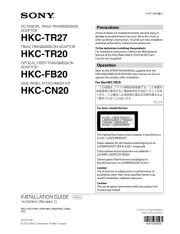
11 Augustus 2025
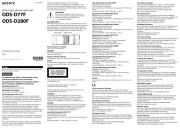
6 Augustus 2025
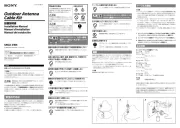
6 Augustus 2025
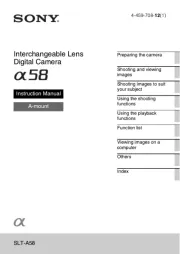
6 Augustus 2025
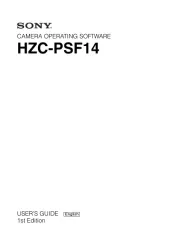
6 Augustus 2025
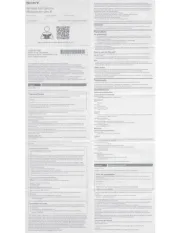
28 Juli 2025
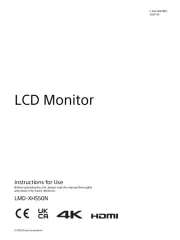
8 Juli 2025
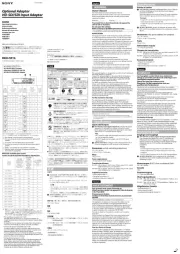
7 Juli 2025
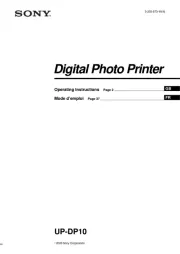
7 Juli 2025
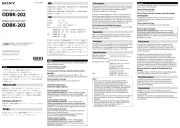
7 Juli 2025
Handleiding Niet gecategoriseerd
- Formuler
- Firefriend
- Sebo
- Global Water
- ACCU-CHEK
- Pontec
- Bluebird
- MantelMount
- Kunft
- Cleco
- Flow Fitness
- Eschenbach
- Ultimate Support
- Schlage
- EarthQuaker Devices
Nieuwste handleidingen voor Niet gecategoriseerd

13 September 2025

13 September 2025

13 September 2025

13 September 2025

13 September 2025

13 September 2025

13 September 2025

13 September 2025

13 September 2025
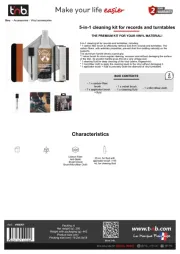
13 September 2025